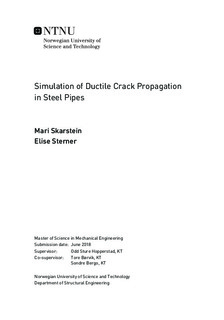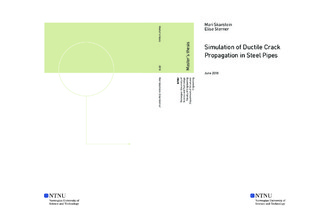| dc.contributor.advisor | Hopperstad, Odd Sture | |
| dc.contributor.advisor | Børvik, Tore | |
| dc.contributor.advisor | Bergo, Sondre | |
| dc.contributor.author | Sterner, Elise | |
| dc.contributor.author | Skarstein, Mari | |
| dc.date.accessioned | 2019-09-11T08:35:13Z | |
| dc.date.created | 2018-06-11 | |
| dc.date.issued | 2018 | |
| dc.identifier | ntnudaim:19746 | |
| dc.identifier.uri | http://hdl.handle.net/11250/2614926 | |
| dc.description.abstract | For the transport of gases and liquids, such as CO2, in steel pipelines to be safe, rupture in the pipe should be avoided. A crack in a pressurized pipe may start to propagate rapidly
along the pipeline and run for long distances. Modern steel pipes are ductile and this phenomenon is denoted running ductile failure. The crack will propagate as long as the pressure level at the crack tip is sufficiently high for the ductile failure processes to occur.
In this study, solid element analyses were used to simulate ductile failure and running
ductile failure in a part of a pipeline with an initial crack. The material behaviour of X65
steel was first established by quasi-static tension tests on different notched specimens, and parameters for a Gurson-Tvergaard-Needleman (GNT) model were calibrated through inverse modelling in Abaqus. The developed GTN model was then validated for a Kahn
tearing test using the same X65 steel, and the phenomenon of tunneling in the Kahn tests
was studied using X-ray computed tomography (CT). As the GTN model was found able
to represent fracture in the tearing test, it was then used to establish fracture energy and
nominal stress parameters for a Cohesive Zone (CZ) model. This was then used to perform
a solid element analysis on a part of a pipeline using a simplified load case. The CZ model
was found to be able to represent the fracture in a sufficient manner, but the crack length
in the pipe proved to be dependent on the global element size used in the simulations. A
GTN model was also established for a part of the pipeline, and was found to represent the
fracture in a similar manner as the CZ model.
For further studies a numerical model of the pipe could be developed where the pres-
sure is applied as a function of the position of the crack tip, and to validate the model by
comparing it to a fluid structure model. A less mesh-sensitive non-local GTN model could
also be established | en |
| dc.language | eng | |
| dc.publisher | NTNU | |
| dc.subject | Produktutvikling og produksjon, Industriell mekanikk | en |
| dc.title | Simulation of Ductile Crack Propagation in Steel Pipes | en |
| dc.type | Master thesis | en |
| dc.source.pagenumber | 99 | |
| dc.contributor.department | Norges teknisk-naturvitenskapelige universitet, Fakultet for ingeniørvitenskap,Institutt for konstruksjonsteknikk | nb_NO |
| dc.date.embargoenddate | 2021-06-11 | |

